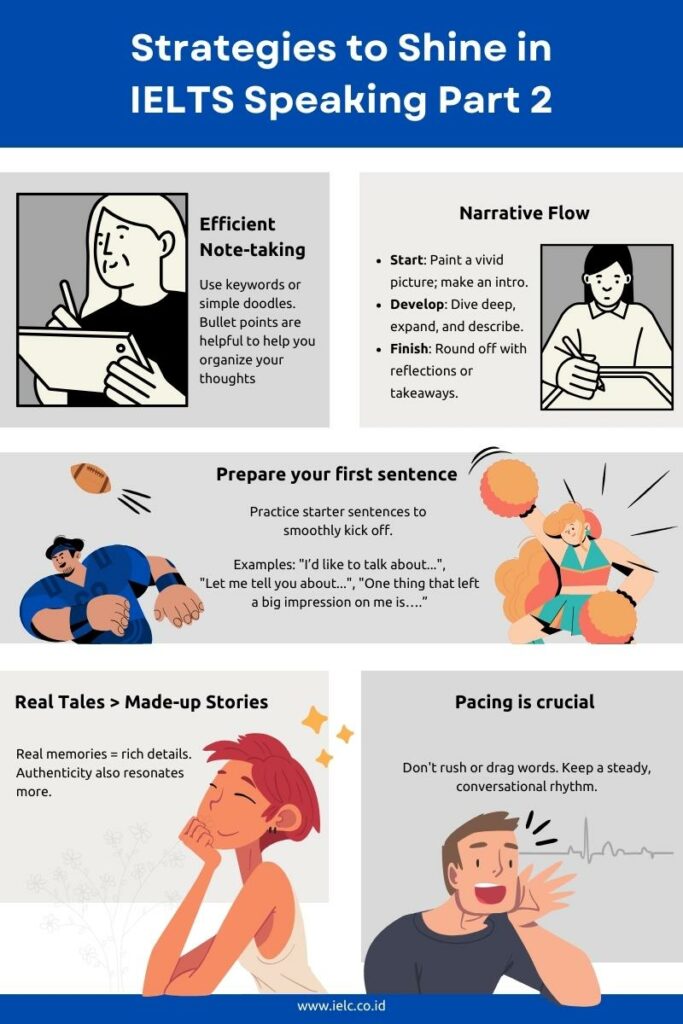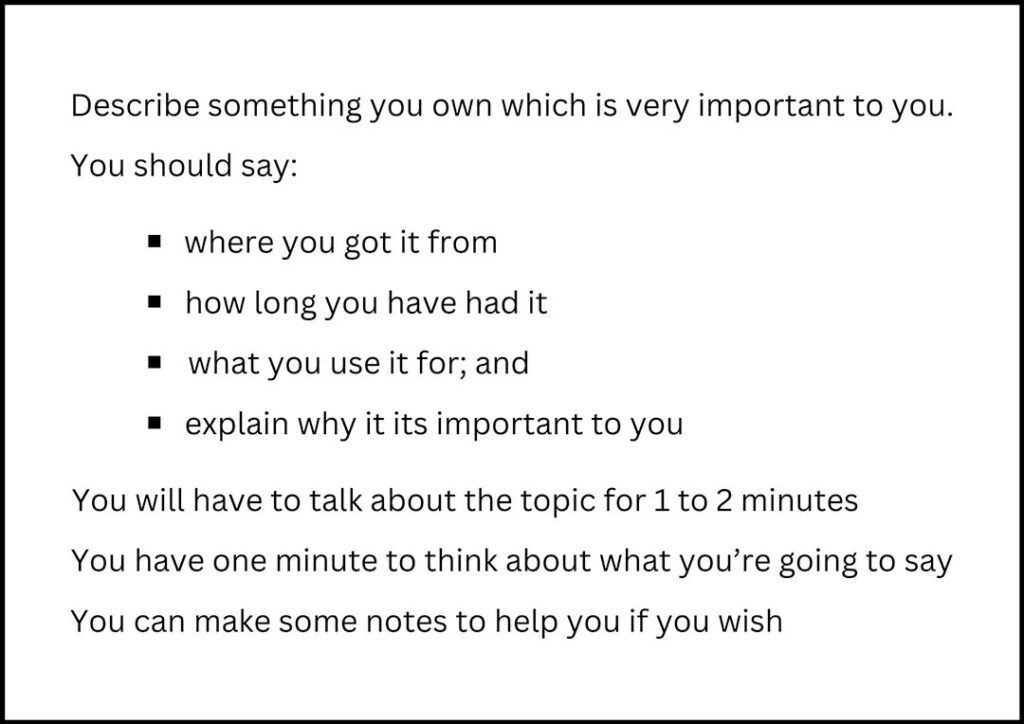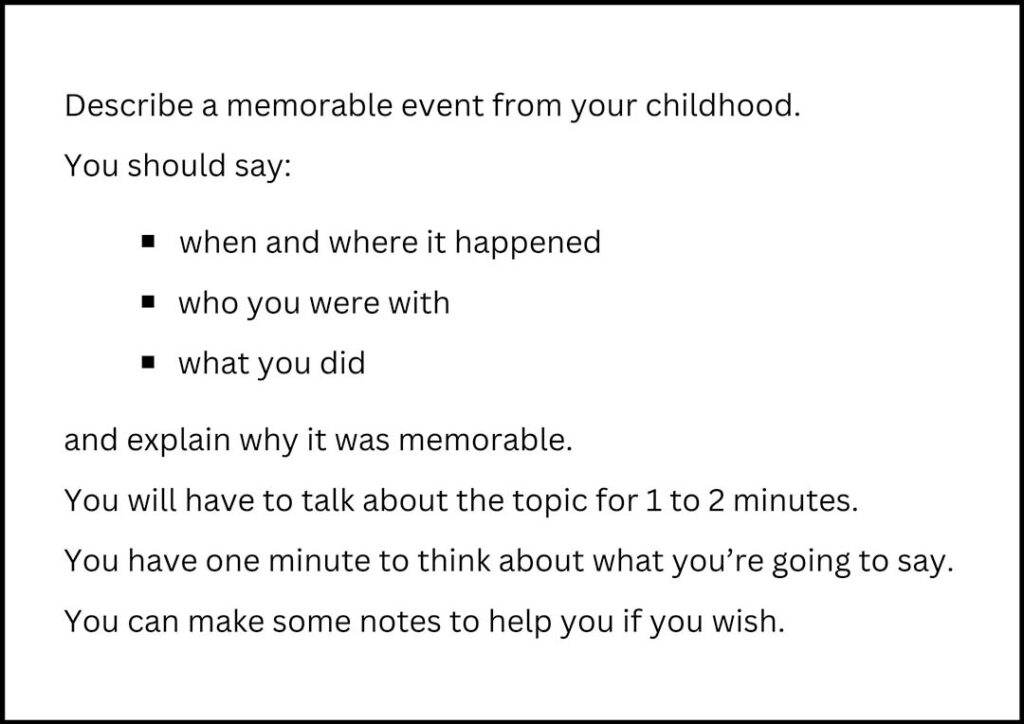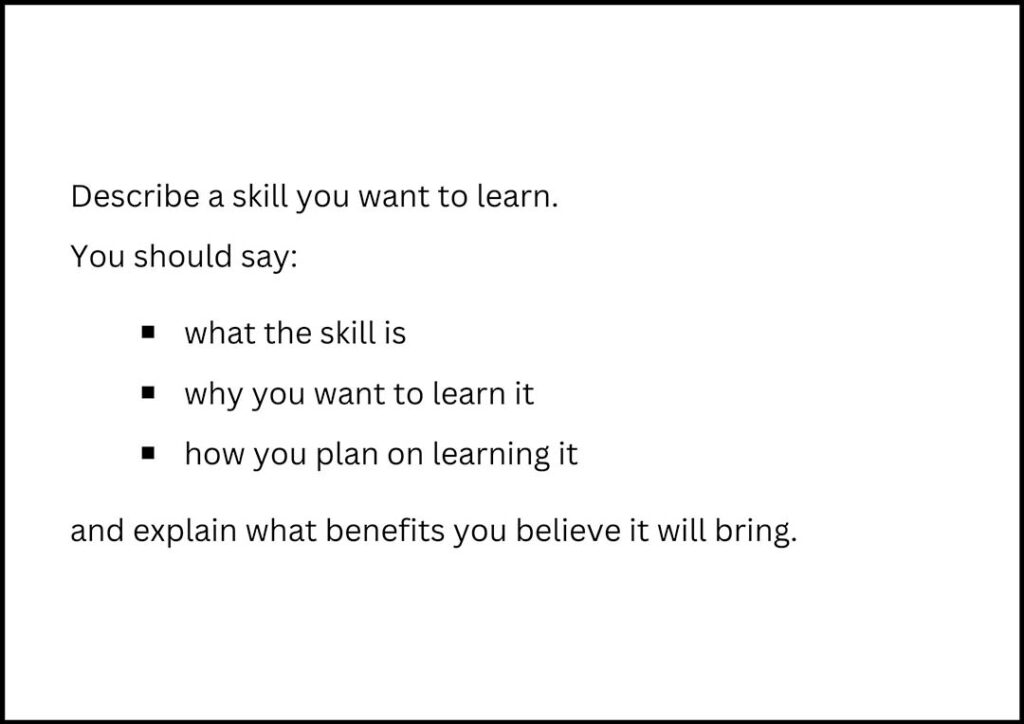
IELTS Speaking Test: A deep dive into part 2
Hello, future IELTS champions!
After acing Part 1 with confidence and poise, it’s time to navigate the depths of Part 2. This is where your storytelling abilities will shine! Ready to dive in? Let’s unravel the secrets of this section.

Speaking Test Part 2 Overview
In this section, you’ll receive a task card that describes a topic you’ll need to talk about. But don’t worry; it also contains points to guide your response.
Duration
Preparation Time: 1 minute
Speaking Time: 1-2 minutes
Content
Task Card: This card presents the main topic and sub-points to guide your speech.
Preparation: With your handy pencil and paper, jot down notes to structure your response.
Your talk: This is your moment! Speak confidently, addressing the points on the task card. Remember, it’s just you talking — no interruptions from the examiner until you’re done.
Decoding the Task Card
Task cards usually come in this format:
Describe [a specific topic].
You should say:
- Point 1 (e.g., when and where it happened)
- Point 2 (e.g., who you were with)
- Point 3 (e.g., how you felt about it)
- And explain why [a specific detail about the topic].
For example:
Speaking Test part 2: candidate task card

Sample topics and answers for IELTS

Sample answer:
One of my most cherished childhood memories took place during the summer of 2003 in my grandmother’s quaint village home, nestled amidst rolling hills and dense forests. It was the eve of my 8th birthday, and instead of a regular celebration, I was having a grand countryside adventure!
I was accompanied by my younger brother and a few village kids whom we had befriended. That evening, we decided to camp out in the backyard. With the help of my grandmother, we set up a tent, laid down sleeping bags, and lit a small campfire. As night fell, the only sounds were the soft crackling of the fire and the distant hooting of an owl.
Under the canopy of a starlit sky, we exchanged ghost stories, trying to outdo each other in crafting the spookiest tale. The atmosphere was electric, with every rustle of leaves or sudden gust of wind sending a thrilling chill down our spines. My grandmother later joined in, sharing age-old legends of the village, adding a touch of authenticity to our fanciful tales.
But what made that night truly special wasn’t just the camping, but being together. In that moment, surrounded by nature and the people I cared about, I felt incredibly happy and connected. It was a magical childhood night I’ll always remember.
Cue Card

Sample answer:
My most cherished item is my journal. It’s a beautifully crafted leather book with a detailed design on its cover. This isn’t just any journal; it was a thoughtful gift from my best friend on my 18th birthday. Now, after being with me for almost five years, it’s filled with countless memories and thoughts.
I write in it every day, sometimes multiple times per day. It’s my personal space where I can freely jot down my thoughts, feelings, dreams, and reflections. It has seen me through the best times and has offered comfort during the tougher ones.
Calling it just a “book” doesn’t do it justice. This journal has become a record of my personal growth and experiences in life. When things get a bit overwhelming or confusing, turning its pages helps me find clarity and perspective. It’s also a storehouse of past memories and future hopes. Looking back at older entries, I can see how much I’ve changed and grown over time.
In many ways, this journal feels deeply connected to me. It’s like a reflection of my inner world, a friend who’s always there, and a history book of my personal journey. Even though it’s a physical item, its value goes beyond that – it’s a special space that holds a piece of my heart and mind.
Cue Card

Sample answer:
A skill I’ve been yearning to learn is playing the guitar. Music has always resonated deeply with me, and the guitar, in particular, has a certain allure. Its strings seem to weave stories, and its melodies evoke emotions in a way few other instruments can.
My drive to learn this instrument comes from wanting to share my emotions and experiences through its music. I’ve always turned to songs for comfort during challenging times, and I dream of crafting melodies that can offer the same solace to others.
To bring this dream to life, I plan to join a local music school. While there’s no shortage of online lessons, I believe that learning in person from an experienced teacher has its own unique value. Getting immediate feedback, understanding the nuances, and being in an environment where music thrives can make a world of difference. Additionally, being part of a community of guitar enthusiasts will inspire and motivate me to continuously improve.
Learning to play the guitar, I believe, will not only be a medium of self-expression but also a therapeutic outlet. The process of mastering chords, creating tunes, and eventually composing songs will undoubtedly enhance my creativity, patience, and focus. Moreover, it’ll be a beautiful way to bond with fellow music lovers!
Strategies to shine in Part 2
1. Efficient note-taking
Mastering quick note-making is a game-changer for the IELTS Speaking Part 2. You’ve got just a minute, so skip the long stories and stick to keywords or even doodles that jog your memory. Also, bullet points are your best buddies here – they keep your thoughts in order and make sure you hit all the main points!
It’s all about keeping it simple, linking ideas smoothly, and, of course, practicing a bunch. With time and practice, you’ll get the hang of organizing your thoughts swiftly and smashing that speaking section!
2. Narrative flow
Having a good narrative flow isn’t just for bedtime stories or movie plots. It’s super useful for IELTS Speaking Part 2 as well! Think about it: an answer with a beginning, middle, and end is way easier to follow and way more engaging. Here’s why crafting this flow can be a big win for your IELTS score:
Kick It off right (the beginning):
- Start strong by setting the scene. This isn’t just about answering the “what” or “when,” but painting a vivid picture. For instance, instead of just saying, “I read a book last summer,” try something like “Last summer, during those endless rainy afternoons, I stumbled upon a book that looked intriguing.”
- Introduce the main characters, settings, or themes you’ll dive into. This helps the examiner get a glimpse of where your story’s headed.
Dive deep (the middle):
- This is where the meat of your story lies. Expand on the points you introduced at the beginning.
- If it’s an event, describe what happened, the challenges faced, or the emotions felt. If it’s an item, like a book or gadget, get into its features, what stood out, or why it was memorable.
- Using descriptive words and varying your vocabulary here can showcase your language proficiency and keep your story captivating.
Wrap tt up (the end):
- Conclude your story with reflections, results, or learnings. For example, “That book not only kept me company through the rain but also introduced me to the world of mystery novels.”
- The ending should tie back to the beginning, making your narrative come full circle and feel complete.
- Remember, a well-rounded conclusion can leave a lasting impression on the examiner, ensuring they remember your response amidst all the answers they hear.
3. Always use genuine stories when possible
Sharing real stories from your life, instead of cooked-up tales, often leads to a smoother and more compelling delivery. Why? For starters, real memories come with built-in details, making your narrative rich and vivid. You don’t have to fumble for what comes next; it’s already etched in your mind. This clarity translates to a logical flow in your speech without extra effort.
Moreover, true stories are tinged with real emotions. Whether it’s the amusement from a funny mishap or the nostalgia of a childhood memory, genuine feelings add depth to your words. It makes your story resonate, setting it apart. And here’s a bonus: Examiners, being humans, can sense authenticity. A true tale, told with emotion, will always leave a stronger impression than a rehearsed one!
4. Don’t speak too quickly
When it comes to IELTS Speaking Part 2, pacing is crucial. It’s not just about what you say, but how you say it. Speaking too rapidly can muddle your pronunciation, making it challenging for the examiner to follow along. On the other hand, dragging your words or speaking too slowly might give the impression that you’re struggling with fluency and coherence.
So, what’s the middle ground? Aim for a steady, natural pace. Think of it as a conversation with a friend – you wouldn’t rush through your stories with them, nor would you painstakingly draw out every word. By keeping a conversational rhythm, you ensure that your pronunciation remains clear and your narrative retains its flow.
5. Prepare your first sentence
How you start your talk can greatly impact the rest of the talk! So, it’s important to have a smooth start.
It‘s a good idea to practice a list of starter sentences. These do not have to be long; the goal is to get the ball rolling for the following supporting sentences.
For example, if you get the topic ‘describe your favorite teacher’, your first sentence could be something like.
“I am lucky to have had several great teachers in the past, but my favorite teacher of all time is definitely Ms.…”
Here are some sample starting sentences you can use to adapt to different topics:
I’d like to talk about…
Let me tell you about…
My favorite thing about … is…
One thing that left a big impression on me is….
This is a very interesting topic and I’d like to start by mentioning…
Summary
While Part 2 demands a bit more depth compared to Part 1, with the right strategy and practice, it becomes less daunting. Your personal experiences are the star of this section. Share them with confidence, and you’re halfway there!
At IELC, we teach English the right way
Our goal is to get you speaking in English with fluency and confidence as fast as possible. We want to give you the skills you need to fulfil your potential!
Our experienced teachers will guide you along every step of the learning process to ensure that you are not wasting your time, money, and energy on useless language exercises & wrong methods.
Our courses
With our modern campus and technology, we are equipped to provide the best possible courses for children, teens, and adults, including:
Online and on campus IELTS courses
Online and on campus TOEFL PBT courses
Online and on campus TOEFL iBT courses
We offer our classes in group classes or private classes.
No matter what your goals are, our team will help you achieve these goals by providing you with Indonesia’s best English courses!
Talk to our team today to get your FREE consultation and take your first step towards success.
Sincerely,

IELC Academic Director
